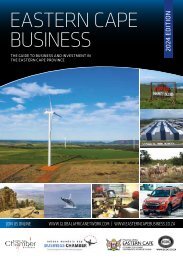Mpumalanga Business 2022-23
The 2022/23 edition of Mpumalanga Business is the 13th issue of this successful publication that since its launch in 2008 has established itself as the premier business and investment guide for the province. With messages of welcome to potential investors from both the provincial premier and the MEC responsible for Economic Development and Tourism, this edition of the journal also contains the official Mpumalanga Investment Prospectus, a comprehensive survey of the province’s assets and the potential of the region. Major catalytic projects such as the Nkomazi Special Economic Zone (NSEZ) and the Mpumalanga International Fresh Produce Market (MIFPM) are examined in detail, outlining how producers, processors and logistics firms stand to benefit and where there is potential for investment. In addition to the Prospectus, the journal contains a special feature on education and a series of brief news briefs about some of the most important sectors in the provincial economy.
The 2022/23 edition of Mpumalanga Business is the 13th issue of this successful publication that since its launch in 2008 has established itself as the premier business and investment guide for the province.
With messages of welcome to potential investors from both the provincial premier and the MEC responsible for Economic Development and Tourism, this edition of the journal also contains the official Mpumalanga Investment Prospectus, a comprehensive survey of the province’s assets and the potential of the region. Major catalytic projects such as the Nkomazi Special Economic Zone (NSEZ) and the Mpumalanga International Fresh Produce Market (MIFPM) are examined in detail, outlining how producers, processors and logistics firms stand to benefit and where there is potential for investment. In addition to the Prospectus, the journal contains a special feature on education and a series of brief news briefs about some of the most important sectors in the provincial economy.
Create successful ePaper yourself
Turn your PDF publications into a flip-book with our unique Google optimized e-Paper software.
INTERVIEW<br />
The hyperspectral core scanner in use at the Council for Geoscience National Core Library.<br />
making this financially viable so it is important to<br />
mention that these areas are below the current<br />
coal fields. You would not need to transport the<br />
CO2 very far to be stored.<br />
The type of storage is quite critical. At a depth<br />
of about 1km you find saline aquifers. That holds<br />
the type of water that you can’t necessarily use for<br />
anything. If you pump the CO2 into that salty water,<br />
the CO2 slowly reacts with the salt in the water but<br />
it can take up to thousands of years before the CO2<br />
becomes immobile. However, if you store the CO2 in<br />
the type of rocks that we are looking at, that reaction<br />
can theoretically happen much quicker. The sooner<br />
you convert the gaseous CO2 into a solid CO2, the<br />
sooner it is rendered immobile. Then it cannot move<br />
around and get back into the atmosphere.<br />
What effect would these processes have on the<br />
environment?<br />
A lot of our work so far has been specifically on<br />
environmental monitoring. This is a critical point.<br />
Before we actually develop this technology, we<br />
are doing a significant amount of environmental<br />
research to make sure that we can understand the<br />
baseline environmental conditions on the ground.<br />
We want to get a footprint of the area – the flora, the<br />
fauna, the chemistry of the groundwater, the amount of<br />
groundwater there is – all of that information.<br />
Are CGS staff excited about the CCUS project?<br />
Yes. It is a very big project. The principle is that it’s<br />
a challenge. There are a lot of different opinions<br />
around the transition. Some say we are not moving<br />
fast enough. Others say we are moving too fast.<br />
This is the nice thing about being pragmatic – a<br />
fundamental scientist if you like – being practical and<br />
finding solutions that will be sustainable.<br />
Our technology for renewables is still developing;<br />
we are not there entirely yet. It’s a big challenge and<br />
we need to buy ourselves some time. For the first<br />
time in a long time, the issue is being looked at<br />
directly by scientists, not necessarily only by policymakers.<br />
We have to guide them, we need to show<br />
what is possible, scientifically and empirically. How<br />
do you present empirical data that has passed peer<br />
review? That is the principle that we are focusing on.<br />
The carbon capture project is a large, integrated<br />
project. The project is funded both by the South<br />
African Government and the World Bank and the<br />
entire project budget is about $<strong>23</strong>-million.<br />
MPUMALANGA BUSINESS <strong>2022</strong>/<strong>23</strong><br />
34


















